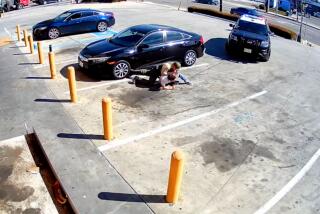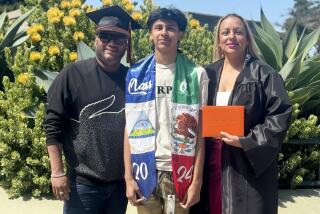U.S. Probes Alleged LAPD Beating
- Share via
The U.S. Department of Justice has opened an investigation into an alleged vigilante mission by a group of Los Angeles police officers accused of tracking down and beating a young man who had thrown a half-empty can of beer at an off-duty officer’s car.
A federal prosecutor in Washington has requested court documents, transcripts, police records and other information about the Feb. 8, 1999, incident as part of an investigation into alleged civil rights violations, according to attorneys contacted by the Justice Department official.
“The Civil Rights Division is reviewing the matter to see what, if any, actions under federal civil rights statutes may be appropriate,” said Casey Stavropoulos, a spokeswoman for the Justice Department in Washington.
The incident, which was detailed in a Times article last year, began when Travis Garlits, 21, threw the can at an officer’s car. It ended with officers tracing Garlits to a Mission Hills home about 10:45 p.m., where he was watching television with friends. Witnesses said the officers burst into the house with guns drawn and ordered everyone to the floor.
One officer beat the man, witnesses said.
The officer was quoted as telling Garlits that he had messed “with the LAPD,” as he allegedly punched and kneed Garlits. “That was my partner you threw the beer can at.”
In addition to the alleged beating of Garlits, police shot and wounded Steven Short, the owner of the house, who later told police he had been awakened by the commotion and grabbed his shotgun. According to a report later by the Police Commission’s inspector general, Jeffrey C. Eglash, by the time Short realized that the intruders were police and started to drop his gun, it was too late: An officer shot him in the hip. .
Short sued the city and received a $300,000 settlement.
The case set off heated debate on the commission. Some commissioners accused the officers of taking the law into their own hands and exacting revenge on Garlits. Eglash recommended that the case be submitted to the U.S. attorney for potential prosecution of the officers. But the case was never submitted by the LAPD for prosecution.
It is unclear what brought up the Justice Department’s recent interest in the case, now nearly 3 years old. Assistant U.S. Atty. Jerrob Duffy, who is based in Washington and who contacted attorneys connected to the case, declined to comment. A lawyer for the city of Los Angeles who represented the officers in the suit brought by Short was not available to discuss the Civil Rights Division actions; the officers previously have declined to comment.
Attorney Carol Watson, who represented Short, said Duffy told her in a telephone conversation last week that he was pursuing a possible criminal civil rights prosecution against the officers.
Duffy sought documents associated with the alleged beating and asked her opinion about impression some of the alleged victims would make as witnesses at trial, Watson and another attorney close to the case said.
An LAPD spokesman, Cmdr. Gary Brennan, said department officials were unaware of the investigation and therefore could not comment on it.
According to police reports, Garlits threw the beer can at the car driven by off-duty Officer Chad Butler, who was on his way home after work. After his car was struck by the can, Butler drove to the Foothill police station with the license plate number of the suspects’ car. After a DMV check of the plate, Butler and several other on-duty officers headed to the address to which the vehicle was registered.
*
Car Spotted
On the way, the police reports said, the officers spotted the car on the San Diego Freeway. The officers pulled the car over, forced the driver, 22-year-old Kevin Cliborn, to lie on the side of the road and arrested him.
Garlits was no longer in the car. Cliborn alleged that the officers demanded that he tell them where Garlits was. Cliborn said he didn’t know the address of the house where his friend was staying, only the phone number.
The officers forced him to call the number and get the address without saying that he was coming with police, Cliborn said.
With that information, the officers headed to Short’s home. On the way to the residence, Cliborn said, one officer told him that he hoped Garlits would “resist arrest,” according to a confidential report by Eglash.
When police arrived, they said, they noticed that the front door was slightly ajar. One of the officers said he knocked on the door and identified himself as a police officer. The knock caused the door to swing open, he said. In the living room, the officers found Garlits and his friends watching television.
Police said Garlits tried to escape and had to be forcefully subdued by Officer Jeffrey Nuttall. At the same time, police said, Short bolted out of a bedroom with a shotgun and pointed it at another officer. That officer, Michael Patton, said he yelled at Short to drop the gun, but the officer said Short refused and started to aim the weapon at the officer’s head. Fearing for his life, Patton said, he shot Short.
The accounts provided by Garlits, Cliborn, Short and others in the house contradicted the police version of events. They said the officers had burst in without warning. Nuttall seized Garlits, they said, and started beating him in the hallway, telling Garlits that he shouldn’t have thrown the beer can at Nuttall’s partner and asking Garlits to “please resist me.”
After the shooting, the non-police witnesses said, Short asked Patton why he had pulled the trigger. “Why did you shoot me?” one witness quoted Short as asking the officer. “You came into my house. I didn’t know you were the police. I was trying to drop the gun.”
Eglash wrote two reports to the Police Commission on the incident, both condemning the officers’ actions. In one, Eglash accused then-Chief Bernard C. Parks of refusing to discipline the officers because Parks disapproved of the way the commission had handled its review of the shooting. The chief denied that charge.
Despite their concerns about the incident, police commissioners found that the shooting had been within departmental rules, which allow officers to fire their guns to protect themselves or others from imminent harm, regardless of the circumstances that led up to the shooting.
*
Case Settled
More than a year later, the inspector general’s reports once again were the center of controversy. When The Times wrote about the incident and detailed the contents of the reports, the judge who had presided over Short’s civil trial fined the city more than $22,000 and ordered a new trial because the reports had not been turned over to Short’s attorney. The city then settled the case out of court.
Watson, Short’s attorney, said the Justice Department prosecutor told her that the federal probe is not focused on the shooting.
She said Duffy had told her that he thought the fact that Short was armed would be difficult to overcome in any potential prosecution, regardless of the circumstances the led up the shooting.
More to Read
Sign up for Essential California
The most important California stories and recommendations in your inbox every morning.
You may occasionally receive promotional content from the Los Angeles Times.











